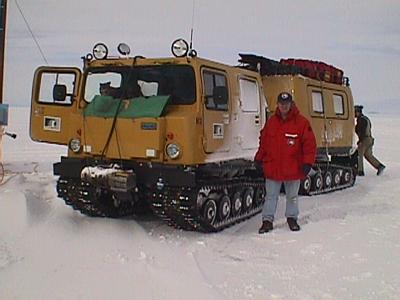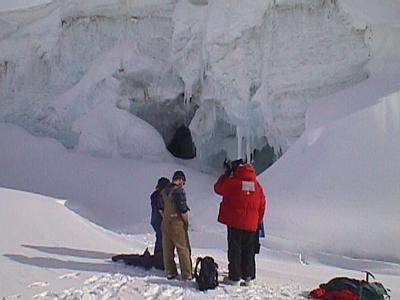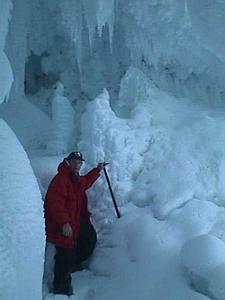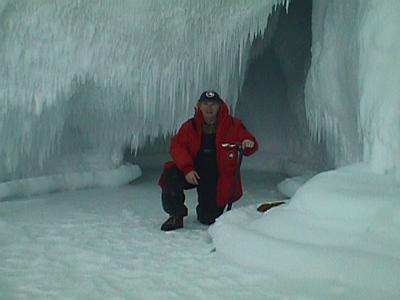17 November, 1999
As I crouch inside this cavern with its beautiful, diffuse blue light and
delicate ice crystals dangling from the ceiling, I can't help but think back
on the course of events that brought me to this place. Two years ago making
application for the TEA program; the waiting and anticipation; getting word
from the head of the NSF Division of Elementary, Secondary, and Informal
Science Education (ESIE) Wayne Sukow that I had been selected. The planning,
the school visits, the apprehension. Meeting with John Wrenn and the
training at LSU. And, then the travel. Appleton to Los Angeles, then to New
Zealand; the C-141 flight to McMurdo; then an hour helo flight to Cape
Roberts. Finally, a bumpy, hour-long traverse across the frozen Ross Sea in
a Haggland has brought me to this place. I find myself inside an ice cave at
the front of the Wilson Piedmont Glacier on the coast of the Antarctic
Continent. My companion, Wojciech, and I have made our way into a small ice
cave. The cave has no footprints in it. We may be the first persons to enter
this parcticular cave. It is quite exhilarating.
Ice caves are formed by melt-water inside of a glacier as it runs toward the
sea. The running water carves a tunnel in the ice. The tunnel may get so big
that it becomes a cave. The largest of the ones we explored was about 20
feet across and 15 feet high and extending back into the glacier about 50
feet or so. We also crawled into some very small, delicate caves as well.
The light inside the cave comes from the sun passing through the blue
glacial ice. In ice caves the ice is so compacted that it looks blue. The
color is due to how the light interacts with the frozen water. Loose and
compacted snow has a lot of air bubbles in it. As light passes through it,
it appears white because of the presence of the air bubbles. (See diagram
below) A blue tone indicates that the pressure from overlying ice and snow
essentially has eliminated the air bubbles in the ice. The less air bubbles
the bluer the light will appear as it passes through.
Inside the surfaces of the ice caves there is a coating of very
delicate ice crystals. Some of the individual crystal are quite large (.5cm
or larger). However, if you touch them or accidentally bump the side of the
cave, the crystals disintegrate into a shower of fine snow. It is just a
marvelous sight. These ice crystals forming a white deposit, called hoar,
results from moisture recrystalizing from the air inside the cave.
Ice caves can be dangerous. Glaciers are dynamic places. The ice is under
stress and is moving. There is often an overhang of snow at the entrance to
the caves. We took precautions when entering the caves. We never went alone
and there was always someone around to help in case of a problem. I am glad
I had the opportunity to explore such a magical place. It was truly an
awesome experience.
Here is an update on the Cape Roberts Project. The drillers have reached
almost 900 meters. The scientists have been confronted with a big surprise.
They have drilled into rock that they did not expect to find. This is true
exploration. The geologists of the CRP hypothesized as to what they would
find when they drilled into the seabed of the Ross Sea. They thought they
would find rocks of the Oligocene epoch then below that rocks of the Eocene
epoch. Instead, they have drilled into rock that is found in outcrop in the
TransAntarctic Mountains that is much older then the rock they expected to
find, perhaps Devonian in age. They are not sure why this rock is where it
is. Many ideas have been discussed, but it is clear to me that in the
process of unraveling this mystery, the geologists will learn a lot that
they don't now know about the geologic history of the Transantarctic
Mountains and the continent of Antarctica. This is science at work. I will
keep you updated as the story unfolds.
Today's featured CRP Team members are a group of Italian petrologists. They
are Franco Talarico and Soyna Sandroni both from the Earth Science
Department at Siena University and Massimo Pompilio from the Institute of
Volcanology in Catania, Italy. This group of geologists is studying the rock
fragments, or clasts, that are imbedded in the sedimentary rocks in the
core. By determining the age and type of clasts, they can make a
determination about the nature of the area surround the place where the
rocks were deposited. So far, they have examined over 20,000 clasts!

As ice is recrystalized under pressure, it forms with less and less air bubbles. Glacial ice has little air in it.

The Haggland vehicle that took me to the ice caves in the Wilson Piedmont Glacier.

Outside the entrance to an ice cave.

The blue color of the light filtered through the glacial ice.

The view through the entrance.

This was truly a thrill of a lifetime.

From left to right: Franco Talarico, Sonya Sandroni and Massimo Pompilio. 20,000 plus clasts is quite an accomplishment.

Contact the TEA in the field at
.
If you cannot connect through your browser, copy the
TEA's e-mail address in the "To:" line of
your favorite e-mail package.
|
